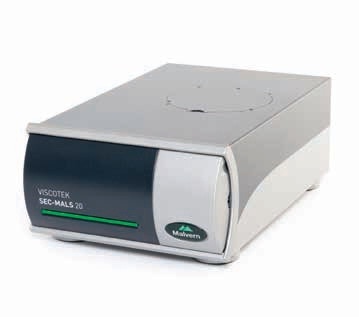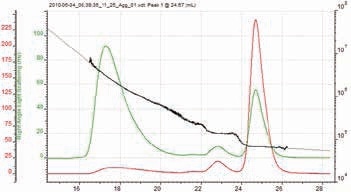A modern research environment needs to have comprehensive information about the molecular properties of a sample, including accurate and precise molecular weight measurements.
Although single detector GPC/SEC systems have been employed for quite a while, they are not able to meet the requirements of evermore demanding applications. Advanced detection techniques are helpful to better understand today’s samples.
Advanced GPC/SEC Systems
The heart of an advanced GPC/SEC system is the light scattering detector, which enables measuring absolute molecular weight independent of sample retention time and structure. A viscometer provides the intrinsic viscosity of a sample by probing the structure of its molecules. Its sensitivity to structural changes is incomparable.
A refractive index or ultraviolet detector facilitates concentration measurement, which is the first step in any sophisticated GPC/SEC measurement. The addition of all these detectors enables an advanced GPC/SEC system to perform comprehensive molecular analysis.
Viscotek Detectors
Using Viscotek detectors, existing GPC/SEC systems can be upgraded to more sophisticated configurations offering the comprehensive range of applications but devoid of the cost of a completely new system.
The Viscotek range is driven by choice and versatility, with the objective of offering a sophisticated detection system customized to the specific requirements of the users. Viscotek detectors cover the complete spectrum of GPC/SEC applications in the polysaccharide, polymer, and protein characterization fields using different measurement technologies, thus providing uncompromising results at the highest quality.
Individually, or in combination, the Viscotek detectors are capable of measuring:
- Composition
- Branching number and frequency
- Molecular structure
- Molecular size (Rh & Rg)
- Mark-Houwink parameters
- Intrinsic viscosity
- Polydispersity
- Absolute molecular weight
- Molecular weight distribution
- 2nd virial coefficient A2 (B22)
Protein Applications
The oligomeric state and correct conformation of a protein largely influence its activity. Biopharmaceutical drugs need to be free from aggregates, and controlling protein conjugates is essential during research as well as in manufactured drugs.
Single-detector GPC/SEC is not able to address the growing challenges in this field, but advanced GPC/SEC detection can be helpful to protein scientists to gain new insights into the behavior of their protein of interest.
The oligomeric state of a protein can be determined the molecular size and weight measurements, whereas the purity of a sample peak can be identified from the polydispersity value.
Advanced GPC/SEC instruments can identify the presence of aggregates and measure their quantity, molecular weight and polydispersity. They can characterize conjugates such as glycosylated, PEGylated, and membrane proteins to determine their molecular weight and composition.
Intrinsic viscosity data is helpful to gain insights into the broad structural changes pertaining to ligand binding. Malvern Panalytical offers systems such as the Zetasizer µV, TDA and SEC-MALS 20 (Figure 1) to better understand these protein properties (Figure 2).

Figure 1. The SEC-MALS 20

Figure 2. Protein oligomers and aggregates shown by Right Angle Light Scattering (RALS) (green) and Refractive Index (RI) (red) chromatograms overlaid with the absolute molecular weight (black).
Synthetic and Natural Polymer Applications
The physical properties of a natural polymer such as hyaluronic acid and a synthetic polymer such as polystyrene are greatly influenced by its molecular properties. Molecular weight, composition, structure and polydispersity all play their part in determining the properties and processability of the final product.
Traditional molecular weight measurements by means of a single detector are not adequate to characterize new polymers entering the market. Viscotek detectors perform absolute measurements of these properties for many different natural and synthetic polymer applications, including polymer research, paints and coatings, food ingredients, drug excipients, tablet coatings, cosmetic and cosmeceuticals.
Molecular weight and molecular weight distribution can strongly impact the strength, toughness, flexibility, durability, and degradation rates of a polymer. The different molecular weight moments also yield data on reactivity or flow properties. The molecular structure of a polymer can be directly measured from the intrinsic viscosity value. Branching of a polymer influences its flow viscosity and processability and can be evaluated from the intrinsic viscosity value.
Copolymers exhibit the properties of their components. Hence, information pertaining to the contribution of the individual components can be obtained by measuring their composition. The 270 Dual Detector and TDA from Malvern Panalytical are helpful to better understand these polymer properties (Figures 3 and 4).

Figure 3. Absolute molecular weight measured by light scattering overlaid on the RI chromatogram.

Figure 4. Mark-Houwink plot of molecular weight vs intrinsic viscosity for polymer structural elucidation.

This information has been sourced, reviewed and adapted from materials provided by Malvern Panalytical.
For more information on this source, please visit Malvern Panalytical.